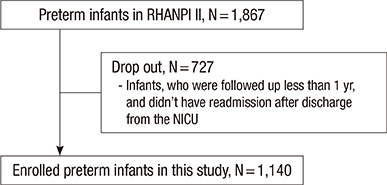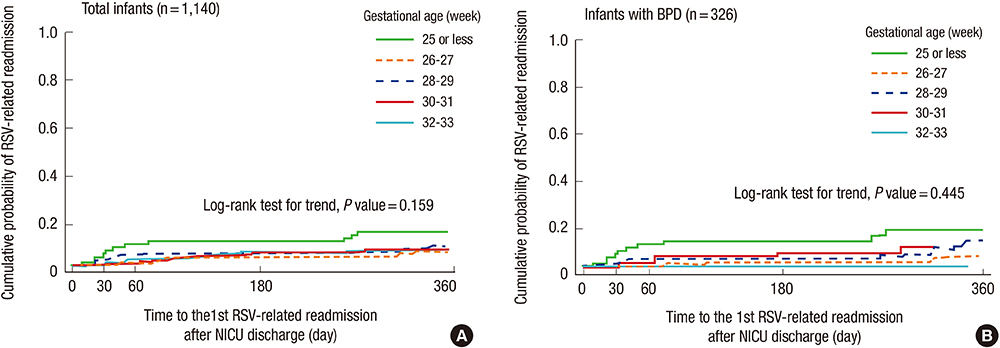J Korean Med Sci.
2015 Oct;30(Suppl 1):S104-S110. 10.3346/jkms.2015.30.S1.S104.
Respiratory Syncytial Virus Related Readmission in Preterm Infants Less than 34 weeks' Gestation Following Discharge from a Neonatal Intensive Care Unit in Korea
- Affiliations
-
- 1Department of Pediatrics, Ajou University School of Medicine, Suwon, Korea.
- 2Department of Pediatrics, Keimyung University School of Medicine, Daegu, Korea.
- 3Department of Pediatrics, Sungkyunkwan University Samsung Medical Center, Seoul, Korea.
- 4Department of Pediatrics, Seoul National University College of Medicine, Seoul, Korea. neona@snu.ac.kr
- KMID: 2351143
- DOI: http://doi.org/10.3346/jkms.2015.30.S1.S104
Abstract
- This study was done to evaluate respiratory syncytial virus (RSV) related readmission (RRR) and risk factors of RRR in preterm infants < 34 weeks gestational age (GA) within 1 yr following discharge from the neonatal intensive care unit (NICU). Infants (n = 1,140) who were born and admitted to the NICUs of 46 hospitals in Korea from April to September 2012, and followed up for > 1 yr after discharge from the NICU, were enrolled. The average GA and birth weight of the infants was 30(+5) +/- 2(+5) weeks and 1,502 +/- 474 g, respectively. The RRR rate of enrolled infants was 8.4% (96/1,140), and RSV accounted for 58.2% of respiratory readmissions of infants who had laboratory tests confirming etiological viruses. Living with elder siblings (odd ratio [OR], 2.68; 95% confidence interval [CI], 1.68-4.28; P < 0.001), and bronchopulmonary dysplasia (BPD) (OR, 2.95; 95% CI, 1.44-6.04; P = 0.003, BPD vs. none) increased the risk of RRR. Palivizumab prophylaxis (OR, 0.06; 95% CI, 0.03-0.13; P < 0.001) decreased the risk of RRR. The risk of RRR of infants of 32-33 weeks' gestation was lower than that of infants < 26 weeks' gestation (OR, 0.11; 95% CI, 0.02-0.53; P = 0.006). This was a nationwide study that evaluated the rate and associated risk factors of RRR in Korean preterm infants. Preterm infants with BPD or living with siblings should be supervised, and administration of palivizumab to prevent RRR should be considered.
Keyword
MeSH Terms
-
Antiviral Agents/therapeutic use
Birth Weight
Bronchopulmonary Dysplasia/drug therapy/pathology
Female
Gestational Age
Humans
Infant
Infant, Newborn
Infant, Premature
Intensive Care Units, Neonatal
Male
Odds Ratio
Palivizumab/therapeutic use
Patient Discharge
Patient Readmission
Republic of Korea
Respiratory Syncytial Virus Infections/drug therapy/*pathology/virology
Respiratory Syncytial Viruses/*isolation & purification
Risk Factors
Siblings
Antiviral Agents
Palivizumab
Figure
Cited by 1 articles
-
Clinical characteristics of lower respiratory infections in preterm children with bronchopulmonary dysplasia
Na Hyun Lee, Se Jin Kim, Hee Joung Choi
Allergy Asthma Respir Dis. 2017;5(2):92-98. doi: 10.4168/aard.2017.5.2.92.
Reference
-
1. Shay DK, Holman RC, Newman RD, Liu LL, Stout JW, Anderson LJ. Bronchiolitis-associated hospitalizations among US children, 1980-1996. JAMA. 1999; 282:1440–1446.2. The PREVENT Study Group. Reduction of respiratory syncytial virus hospitalization among premature infants and infants with bronchopulmonary dysplasia using respiratory syncytial virus immune globulin prophylaxis. Pediatrics. 1997; 99:93–99.3. Muller-Pebody B, Edmunds WJ, Zambon MC, Gay NJ, Crowcroft NS. Contribution of RSV to bronchiolitis and pneumonia-associated hospitalizations in English children, April 1995-March 1998. Epidemiol Infect. 2002; 129:99–106.4. Feltes TF, Cabalka AK, Meissner HC, Piazza FM, Carlin DA, Top FH Jr, Connor EM, Sondheimer HM. Cardiac Synagis Study Group. Palivizumab prophylaxis reduces hospitalization due to respiratory syncytial virus in young children with hemodynamically significant congenital heart disease. J Pediatr. 2003; 143:532–540.5. Palivizumab, a humanized respiratory syncytial virus monoclonal antibody, reduces hospitalization from respiratory syncytial virus infection in high-risk infants. The IMpact-RSV Study Group. Pediatrics. 1998; 102:531–537.6. American Academy of Pediatrics Committee on Infectious Diseases. American Academy of Pediatrics Bronchiolitis Guidelines Committee. Updated guidance for palivizumab prophylaxis among infants and young children at increased risk of hospitalization for respiratory syncytial virus infection. Pediatrics. 2014; 134:415–420.7. Deshpande SA, Northern V. The clinical and health economic burden of respiratory syncytial virus disease among children under 2 years of age in a defined geographical area. Arch Dis Child. 2003; 88:1065–1069.8. Park HW, Lee BS, Kim AR, Yoon HS, Kim BI, Song ES, Kim WT, Lim J, Kim S, Jin HS, et al. Epidemiology of respiratory syncytial virus infection in infants born at less than thirty-five weeks of gestational age. Pediatr Infect Dis J. 2012; 31:e99–e104.9. Chang SG, Park MS, Yu JE. Outcomes of palivizumab prophylaxis for respiratory syncytial virus infection in preterm children with bronchopulmonary dysplasia at a single hospital in Korea from 2005 to 2009. J Korean Med Sci. 2010; 25:251–256.10. Park SK, Jung YJ, Yoo HS, Ahn SY, Seo HJ, Choi SH, Kim MJ, Jeon GW, Koo SH, Lee KH, et al. Effect of Synagis(R) (palivizumab) prophylaxis on readmission due to respiratory syncytial virus in very low birth weight infants. Korean J Pediatr. 2010; 53:358–363.11. Jobe AH, Bancalari E. Bronchopulmonary dysplasia. Am J Respir Crit Care Med. 2001; 163:1723–1729.12. Walsh MC, Kliegman RM. Necrotizing enterocolitis: treatment based on staging criteria. Pediatr Clin North Am. 1986; 33:179–201.13. Papile LA, Burstein J, Burstein R, Koffler H. Incidence and evolution of subependymal and intraventricular hemorrhage: a study of infants with birth weights less than 1,500 gm. J Pediatr. 1978; 92:529–534.14. Garner JS, Jarvis WR, Emori TG, Horan TC, Hughes JM. CDC definitions for nosocomial infections, 1988. Am J Infect Control. 1988; 16:128–140.15. Parnes C, Guillermin J, Habersang R, Nicholes P, Chawla V, Kelly T, Fishbein J, McRae P, Goessler M, Gatti A, et al. Palivizumab Outcomes Registry Study Group. Palivizumab Outcomes Registry Study Group. Palivizumab prophylaxis of respiratory syncytial virus disease in 2000-2001: results from The Palivizumab Outcomes Registry. Pediatr Pulmonol. 2003; 35:484–489.16. Joffe S, Escobar GJ, Black SB, Armstrong MA, Lieu TA. Rehospitalization for respiratory syncytial virus among premature infants. Pediatrics. 1999; 104:894–899.17. Geskey JM, Ceneviva GD, Brummel GL, Graff GR, Javier MC. Administration of the first dose of palivizumab immunoprophylaxis against respiratory syncytial virus in infants before hospital discharge: what is the evidence for its benefit? Clin Ther. 2004; 26:2130–2137.18. Resch B, Resch E, Müller W. Should respiratory care in preterm infants include prophylaxis against respiratory syncytial virus infection? The case in favour. Paediatr Respir Rev. 2013; 14:130–136.19. Kim SJ, Chae SH, Lee JH, Kim YJ, Koo SH, Jeon GW, Chang YS, Park WS. Rehospitalization of Very Low Birth Weight Infants in the First Year after Discharge from NICU and Risk Factor of Rehospitalization caused by Respiratory Illness. J Korean Soc Neonatol. 2006; 13:17–23.20. Lee EA, Jeong JH, Yu ST, Lee CW, Yoon HS, Park DS, Oh YK. Incidence and Risk Factors of Rehospitalization with Respiratory Syncytial Virus Infection in Premature Infants. Korean J Pediatr. 2004; 47:510–514.21. Paes B, Mitchell I, Li A, Harimoto T, Lanctôt KL. Respiratory-related hospitalizations following prophylaxis in the Canadian registry for palivizumab (2005-2012) compared to other international registries. Clin Dev Immunol. 2013; 2013:917068.22. Underwood MA, Danielsen B, Gilbert WM. Cost, causes and rates of rehospitalization of preterm infants. J Perinatol. 2007; 27:614–619.23. Ralser E, Mueller W, Haberland C, Fink FM, Gutenberger KH, Strobl R, Kiechl-Kohlendorfer U. Rehospitalization in the first 2 years of life in children born preterm. Acta Paediatr. 2012; 101:e1–e5.24. Resch B, Pasnocht A, Gusenleitner W, Müller W. Rehospitalisations for respiratory disease and respiratory syncytial virus infection in preterm infants of 29-36 weeks gestational age. J Infect. 2005; 50:397–403.25. Kristensen K, Dahm T, Frederiksen PS, Ibsen J, Iyore E, Jensen AM, Kjaer BB, Olofsson K, Pedersen P, Poulsen S. Epidemiology of respiratory syncytial virus infection requiring hospitalization in East Denmark. Pediatr Infect Dis J. 1998; 17:996–1000.26. Resch B, Gusenleitner W, Mandl C, Müller W. Epidemiology of respiratory syncytial virus infection in Southern Austria. Pediatr Infect Dis J. 2000; 19:587–588.27. Wert SE. The lung: normal and abnormal structural development of lung. In : Polin RA, Fox WW, Abman SH, editors. Fetal and neonatal physiology. 3rd ed. Philadelphia, Pa.: W.B. Saunders;2004. p. 784–794.28. Ballow M, Cates KL, Rowe JC, Goetz C, Desbonnet C. Development of the immune system in very low birth weight (less than 1500 g) premature infants: concentrations of plasma immunoglobulins and patterns of infections. Pediatr Res. 1986; 20:899–904.29. Carbonell-Estrany X, Quero J, Bustos G, Cotero A, Domenéch E, Figueras-Aloy J, Fraga JM, Garcia LG, Garcia-Alix A, Del Río MG, et al. Rehospitalization because of respiratory syncytial virus infection in premature infants younger than 33 weeks of gestation: a prospective study. IRIS Study Group. Pediatr Infect Dis J. 2000; 19:592–597.30. Lacaze-Masmonteil T, Roze JC, Fauroux B. French Pediatricians' Group of Sunagis Patients' Name-Based Programs. Incidence of respiratory syncytial virus-related hospitalizations in high-risk children: follow-up of a national cohort of infants treated with Palivizumab as RSV prophylaxis. Pediatr Pulmonol. 2002; 34:181–188.
- Full Text Links
- Actions
-
Cited
- CITED
-
- Close
- Share
- Similar articles
-
- Use of Medical Resources by Preterm Infants Born at Less than 33 Weeks' Gestation Following Discharge from the Neonatal Intensive Care Unit in Korea
- Hospital Visits from Respiratory Diseases of Early and Late Preterm Infants
- The Readmission of Preterm Infants of 30-33 Weeks Gestational Age within 1 Year Following Discharge from Neonatal Intensive Care Unit in Korea
- Comparison of Clinical Outcomes in Late Preterm Infants between Born at 34+0 to 34+6 Weeks and at 35+0 to 36+6 Weeks of Gestation
- Comparisons of Clinical Characteristics Affecting Readmission between Late Preterm Infants and Moderate Preterm Infants or Full-Term Infants



